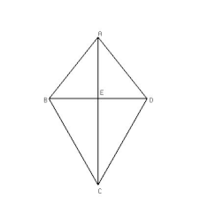I was given the following question:
ABCD is a kite and point E is the intersection of its diagonals. Which of the following transformations in (a)-(d) can be used to prove that [MATH]\triangle ABC \cong \triangle ADC[/MATH] using the transformation definition of congruence?

(a) The rotation around E of 180 degrees
(b) The translation from B to E
(c) The rotation around E of 90 degrees
(d) The reflection with respect to [MATH]\overline{AC}[/MATH]
I'm not sure how to solve this. I know that if I reflect over the line AC, that will map the shape exactly to itself, but I don't know if that proves congruence. I also cannot figure out if any of the other ways can do this. Can anyone help me out a bit?
ABCD is a kite and point E is the intersection of its diagonals. Which of the following transformations in (a)-(d) can be used to prove that [MATH]\triangle ABC \cong \triangle ADC[/MATH] using the transformation definition of congruence?

(a) The rotation around E of 180 degrees
(b) The translation from B to E
(c) The rotation around E of 90 degrees
(d) The reflection with respect to [MATH]\overline{AC}[/MATH]
I'm not sure how to solve this. I know that if I reflect over the line AC, that will map the shape exactly to itself, but I don't know if that proves congruence. I also cannot figure out if any of the other ways can do this. Can anyone help me out a bit?
